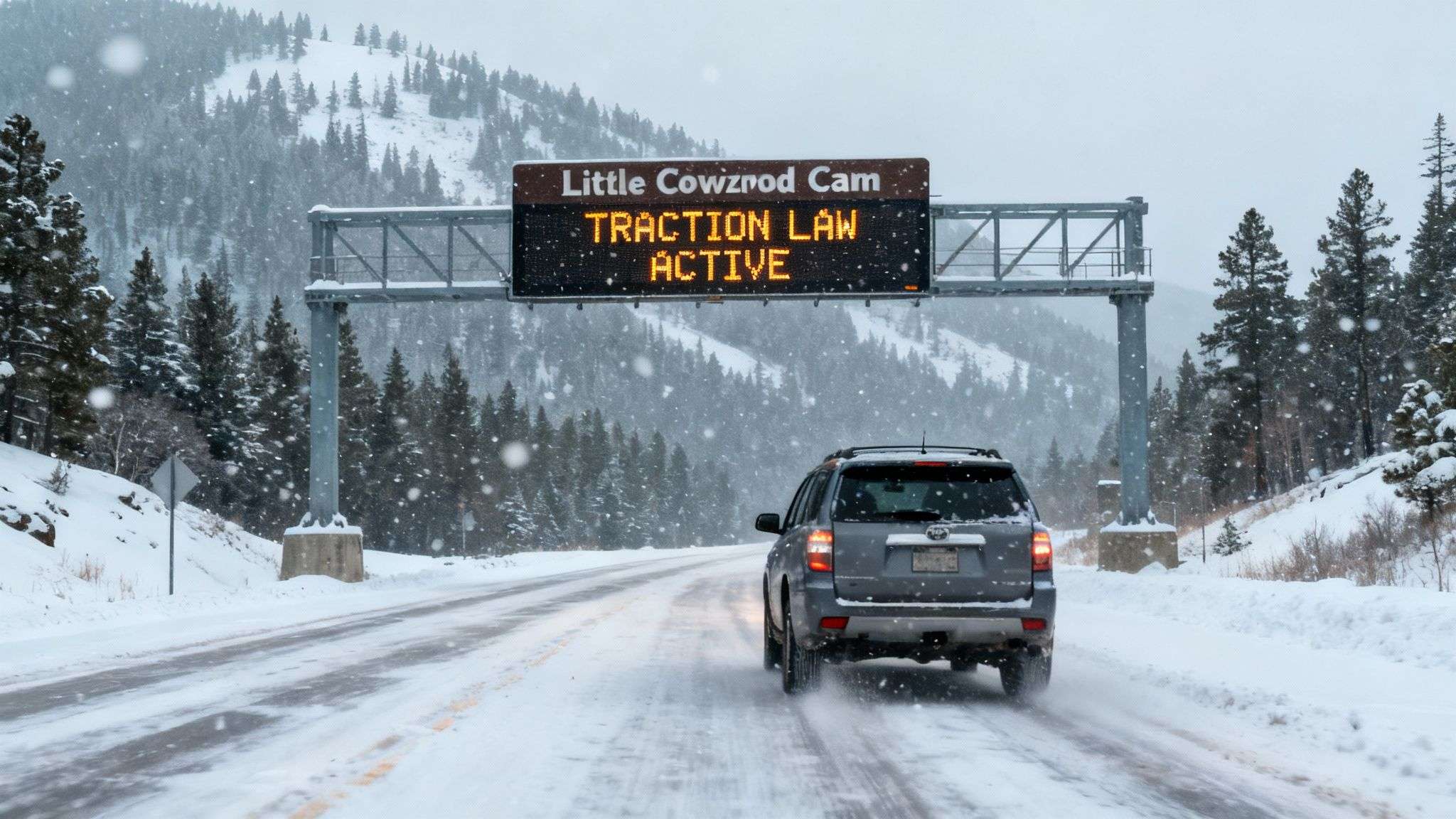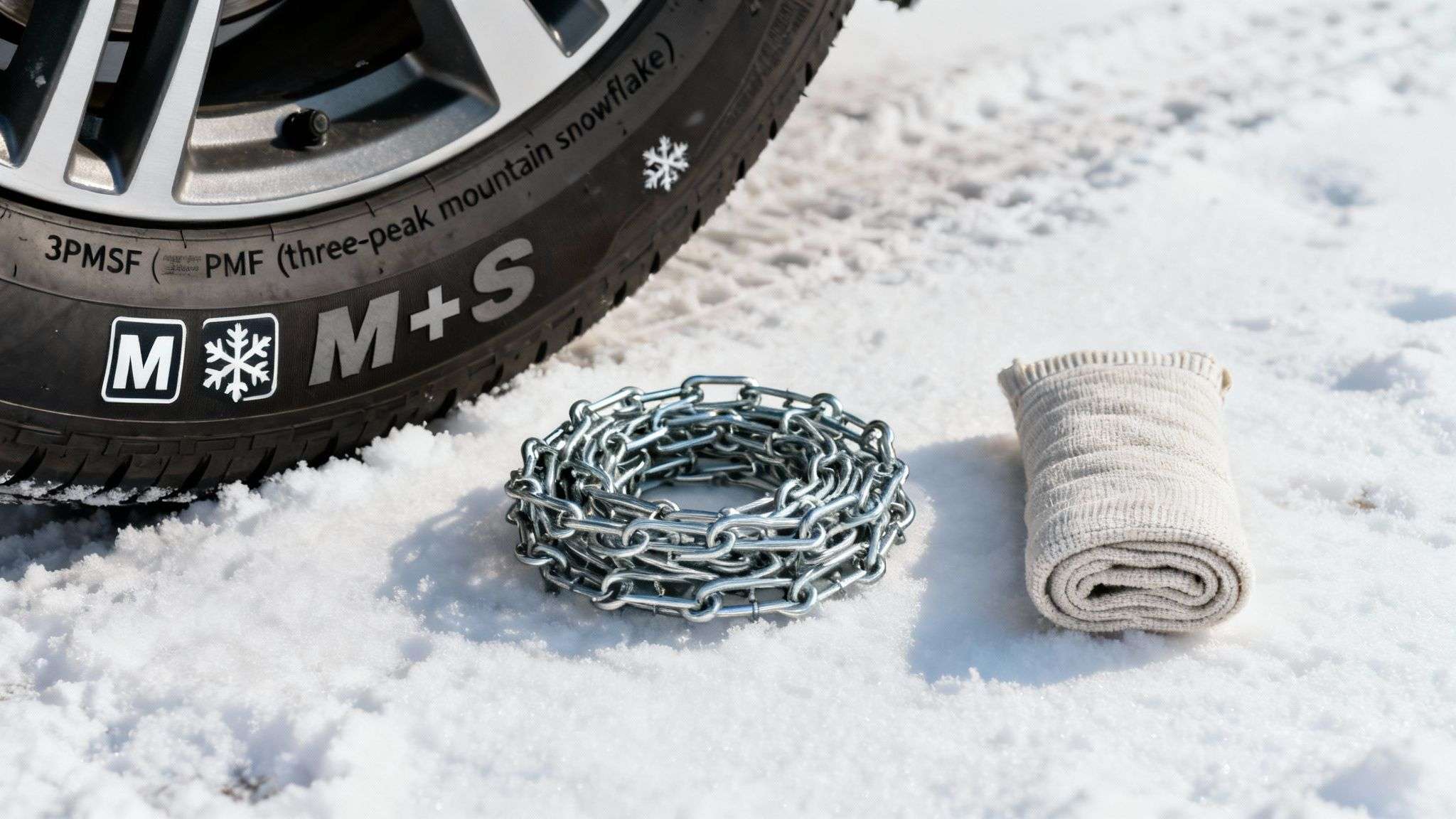Utah Traction Law: A Guide for Canyon Travelers
Utah's traction law is a mandatory safety rule for driving in the canyons during winter. Learn what it is, when it's active, and how to comply with tire and chain requirements.
Utah's traction law is a mandatory safety rule requiring all vehicles in designated canyons to have proper snow tires or carry traction devices like chains. The Utah Department of Transportation (UDOT) activates this law during winter weather to prevent accidents and keep canyon roads open. This guide explains what the law is, when it’s active, and how to ensure your vehicle is compliant.

What is the Utah Traction Law?
Think of the traction law as the mountain's non-negotiable entry requirement during a storm. Its entire purpose is to prevent unprepared vehicles from sliding out—the number one cause of accidents and multi-hour road closures in the Cottonwood Canyons. When UDOT activates the law due to snow or ice, every vehicle must have the minimum required equipment to maintain grip on steep and winding mountain roads.
At its core, the principle is simple: your tires are your most critical safety feature in winter. The traction law ensures every car has the necessary grip to handle steep grades, sharp turns, and icy patches, protecting everyone on the road.
What are the Requirements?
When the traction law is active, your vehicle must have one of the following to pass the checkpoint at the mouth of the canyon:
- Properly Rated Snow Tires: Your tires must have either an M+S (Mud and Snow) or a 3PMSF (Three-Peak Mountain Snowflake) symbol on the sidewall. This rule applies to all vehicles, including those with All-Wheel Drive (AWD) or 4-Wheel Drive (4WD).
- Onboard Traction Devices: If your tires are not rated M+S or 3PMSF, you must carry an approved traction device, like snow chains or tire socks, that are correctly sized for your vehicle’s drive wheels.
Knowing the rules of the road is critical, just as it is in any specialized field. For example, the legal services industry is currently navigating its own set of challenges and changes. Recent analysis reveals a market where law firms are either seeing significant growth or decline, with less room in the middle. You can explore more about these fundamental shifts in law firm performance on thomsonreuters.com. Whether it’s driving up a canyon or navigating a professional landscape, understanding the requirements is the first step to a successful journey.
When is the Traction Law Active?
UDOT activates the traction law based on real-time road conditions, not a fixed schedule. It is triggered when snow or ice makes driving genuinely dangerous. You can predict when the law will go into effect by watching for these conditions:
- Active Snowfall: As soon as a storm begins to accumulate snow on the road.
- Icy Conditions: Any report of black ice or hard-packed snow, especially in shaded areas.
- Poor Visibility: Heavy or blowing snow that reduces sight lines and hides slick spots.
Our live data for Little Cottonwood Canyon shows that during major storm cycles, the traction law is often active for 24-48 hours continuously. For example, during the storm on January 14, 2024, the law was implemented at 6 AM and remained in effect until road conditions improved two days later.
How to Prepare for the Traction Law
Guessing if the traction law is active is a recipe for a failed trip. Fortunately, UDOT provides several ways to know the road status before you leave. By checking official sources and having the right equipment, you can travel with confidence.
How to Check the Current Status

Before you head to the mountains, always check the current road status using these official resources:
- UDOT Traffic Website & App: This is your most reliable source for live alerts, road closures, and traffic camera feeds.
- On-the-Road Signs: Large electronic signs on approach routes like I-215 will flash clear messages like "TRACTION LAW IN EFFECT" or "4WD/AWD OR CHAINS REQUIRED."
- Wasatch Roads: Our pages for Little Cottonwood Canyon and Big Cottonwood Canyon provide real-time status updates and historical data.
We break down how to interpret all of these sources in our complete guide to checking UDOT road conditions in Utah.
How to Get Your Vehicle Compliant
Compliance comes down to your tires. An AWD or 4WD system helps you go, but only proper tires help you stop and turn safely.

To check if your tires are compliant, look for these symbols on the sidewall:
- M+S (Mud and Snow): This meets the minimum legal requirement. It indicates the tire tread is designed to perform better than a summer tire in mud and light snow.
- 3PMSF (Three-Peak Mountain Snowflake): This is the gold standard. A 3PMSF-rated tire has passed a standardized test for accelerating on packed snow, offering superior grip and braking performance.
If your tires lack these symbols, you must carry an alternative traction device (ATD) like snow chains or tire socks. While an M+S tire is legally sufficient, we strongly recommend 3PMSF tires for anyone who frequently drives the canyons in winter. For more tips, see our guide on how to safely drive in specific weather conditions.
What Happens if I'm Not Compliant?
Ignoring the traction law has serious consequences. Best case, you'll be turned away at the canyon entrance and face a fine of over $250. Worst case, you could cause an accident that closes the road for hours, endangering yourself and others.

A single unprepared vehicle is the most common cause of winter closures in the Cottonwood Canyons. Compliance isn't just a personal choice; it's a community responsibility to keep the roads safe and open for everyone.
Think about it this way: a law firm that fails to adapt to market changes creates instability for its entire staff. When market pressures hit, firms have to react. For example, legal industry data shows that lateral partner hiring jumped by 14% in 2024 as firms scrambled to strengthen key departments after a two-year slowdown. At the same time, non-equity partnerships grew by 5.3% in 2023, reflecting a shift toward more flexible models to keep the whole operation stable. You can read more about these evolving legal industry trends at talentohc.com. Just as those firms must adapt to protect their people, drivers must adapt to winter conditions to protect the entire canyon community.
Actionable, Local Tips
- Check Tire Pressure: Cold air reduces tire pressure. Before heading up, ensure your tires are properly inflated at a gas station near the canyon base for optimal grip.
- Time Your Trip: On powder days, aim to be at the canyon mouth before 7:00 AM or after 1:00 PM to avoid peak traffic and long waits at checkpoints.
- Practice with Chains: If you carry chains or socks, practice installing them in your driveway before you're stuck in a blizzard on the side of the road.
- Pack an Emergency Kit: Always have a blanket, water, snacks, and a small shovel in your car. A road closure can mean a long wait in cold temperatures.
For more detailed strategies, read our guide to mastering winter driving in Little Cottonwood Canyon.
Traction Law FAQ
Does my AWD or 4WD vehicle automatically comply with the traction law?
No. This is the most common misconception. The law is about grip, which comes from your tires. Your AWD/4WD vehicle must still have M+S or 3PMSF-rated tires to be compliant.
Where is the traction law enforced?
UDOT and law enforcement set up checkpoints at the mouths of Little Cottonwood Canyon and Big Cottonwood Canyon. Electronic signs give you plenty of warning, but officers will turn around any non-compliant vehicle.
Can I use chains on a rental car?
Almost always, no. Most rental agreements explicitly prohibit the use of chains, as incorrect installation can cause significant damage. If your rental car doesn't have M+S or 3PMSF tires, your best option is to exchange it for one that does.